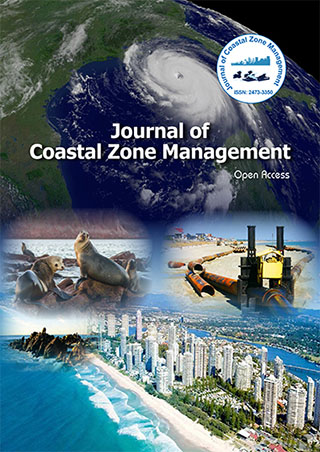Indexed In
- SafetyLit
- RefSeek
- Hamdard University
- EBSCO A-Z
- OCLC- WorldCat
- Publons
Useful Links
Share This Page
Journal Flyer

Open Access Journals
- Agri and Aquaculture
- Biochemistry
- Bioinformatics & Systems Biology
- Business & Management
- Chemistry
- Clinical Sciences
- Engineering
- Food & Nutrition
- General Science
- Genetics & Molecular Biology
- Immunology & Microbiology
- Medical Sciences
- Neuroscience & Psychology
- Nursing & Health Care
- Pharmaceutical Sciences
Perspective - (2024) Volume 27, Issue 3
Perspectives on Water Circulation Patterns and Dwelling Hours: Hydrodynamic Modeling of Coastal Lagoon Systems
Himany Dhinar*Received: 16-Apr-2024, Manuscript No. JCZM-24-25567; Editor assigned: 19-Apr-2024, Pre QC No. JCZM-24-25567 (PQ); Reviewed: 02-May-2024, QC No. JCZM-24-25567; Revised: 09-May-2024, Manuscript No. JCZM-24-25567 (R); Published: 16-May-2024, DOI: 10.35248/2473-3350.24.27.627
Description
Coastal lagoons are dynamic and complex aquatic ecosystems that are influenced by a variety of hydrodynamic processes, including tides, winds, waves, freshwater inputs, and interactions with the adjacent ocean. Hydrodynamic modeling lead significant role in understanding the circulation patterns and residence times of water within coastal lagoon systems, providing valuable insights into ecosystem dynamics, water quality, and pollutant dispersion. This article explores the importance of the hydrodynamic modeling engaging the complexities of coastal lagoon hydrodynamics.
Hydrodynamic modeling involves the use of mathematical equations and computer simulations to simulate the movement of water within a coastal lagoon system. These models take into account a range of physical parameters, including bathymetry, topography, tidal forcing, wind stress, temperature, salinity, and freshwater inputs, to simulate the complex interactions between water masses and predict water circulation patterns over time.
One of the major objectives of hydrodynamic modeling is to understand the driving forces behind water circulation patterns in coastal lagoon systems. Tidal currents, generated by the gravitational pull of the moon and sun, lead a dominant role in shaping water movement within lagoons, causing water to flow in and out of the lagoon through inlet channels and tidal gates. Wind-driven currents, influenced by local wind patterns and coastal morphology, also contribute to water circulation, especially in shallow lagoons with limited tidal exchange.
By simulating these hydrodynamic processes, hydrodynamic models can accurately predict water circulation patterns, including the direction, velocity, and magnitude of currents, as well as the spatial and temporal variability of water properties such as temperature, salinity, and turbidity. Understanding these circulation patterns is essential for assessing sediment transport, nutrient cycling, and ecosystem connectivity within coastal lagoon systems.
Another important aspect of hydrodynamic modeling is the estimation of residence times, which refers to the average time it takes for water to exchange within a lagoon system. Residence times are influenced by a variety of factors, including lagoon morphology, tidal amplitude, freshwater inputs, and hydrodynamic connectivity with the adjacent ocean. Short residence times indicate rapid water exchange and efficient flushing of pollutants, while long residence times suggest limited water exchange and significant for pollutant accumulation.
Hydrodynamic models can simulate residence times by tracking the movement of water particles within the lagoon system over time and estimating the time it takes for particles to exit the system through inlet channels or tidal gates. These residence time estimates provide valuable information for assessing water quality, pollutant dispersion, and ecosystem health within coastal lagoon systems.
In addition to understanding water circulation patterns and residence times, hydrodynamic modeling can also be used to assess the impacts of climate change, sea level rise, and anthropogenic activities on coastal lagoon hydrodynamics. Climate change-induced alterations in temperature, precipitation, and sea level can influence water circulation patterns, sediment dynamics, and habitat distribution within coastal lagoon systems, leading to significant shifts in ecosystem structure and function.
Anthropogenic activities, such as coastal development, dredging, and shoreline modifications, can also alter coastal lagoon hydrodynamics by modifying bathymetry, obstructing tidal flow, and increasing sedimentation rates. Hydrodynamic models can simulate the effects of these human impacts and inform management decisions aimed at preserving the ecological integrity and water quality of coastal lagoon systems.
In conclusion, hydrodynamic modeling lead a major role in understanding water circulation patterns and residence times within coastal lagoon systems, providing valuable insights into ecosystem dynamics, water quality, and pollutant dispersion. By accurately simulating hydrodynamic processes and assessing the impacts of environmental change and human activities, hydrodynamic models can inform management strategies aimed at preserving the ecological health and resilience of coastal lagoon ecosystems for ensuing generations.
Citation: Dhinar H (2024) Perspectives on Water Circulation Patterns and Dwelling Hours: Hydrodynamic Modeling of Coastal Lagoon Systems. J Coast Zone Manag. 27:627.
Copyright: © 2024 Dhinar H. This is an open-access article distributed under the terms of the Creative Commons Attribution License, which permits unrestricted use, distribution, and reproduction in any medium, provided the original author and source are credited.
